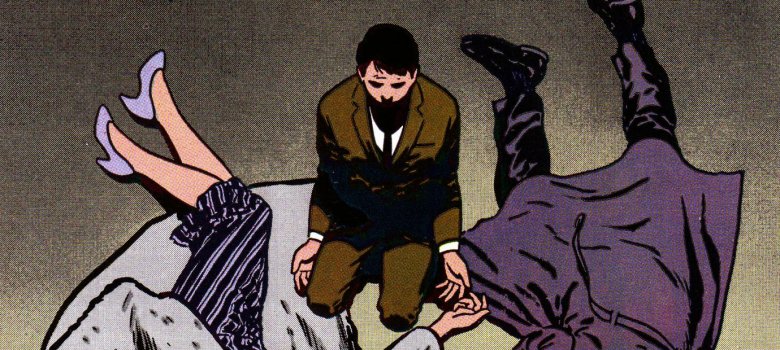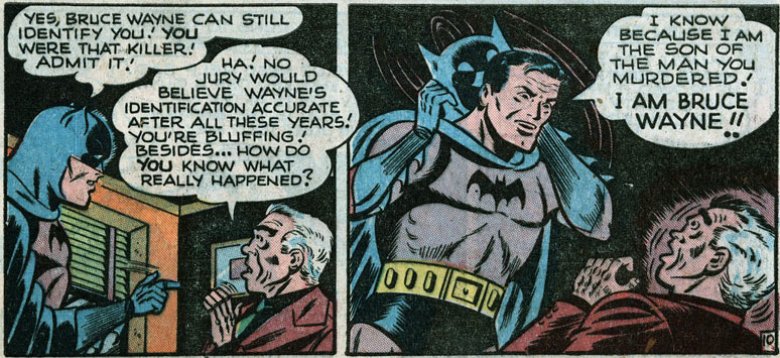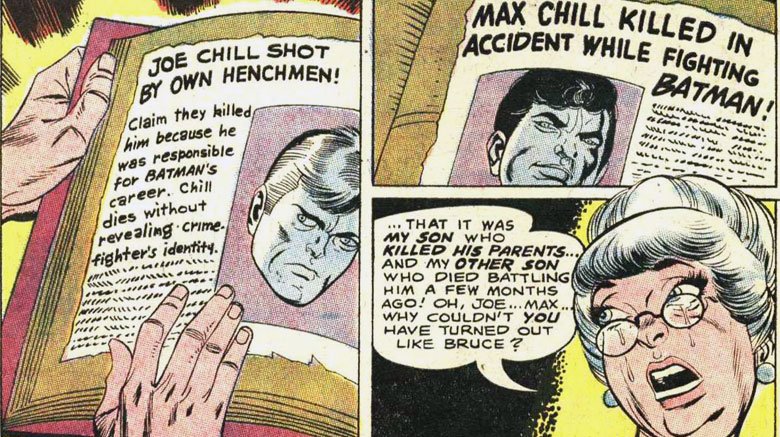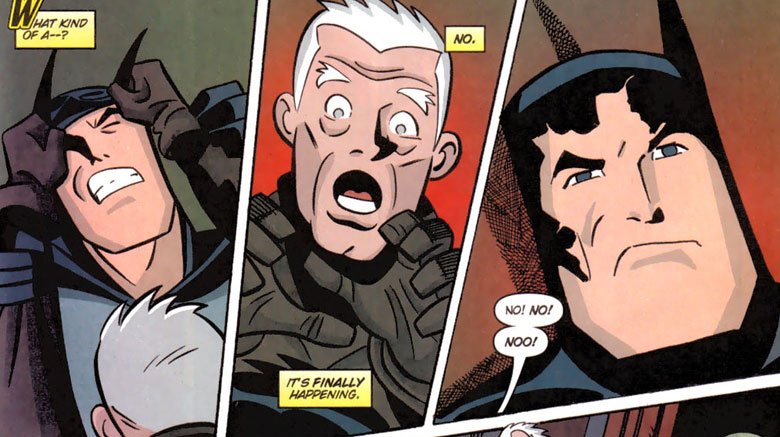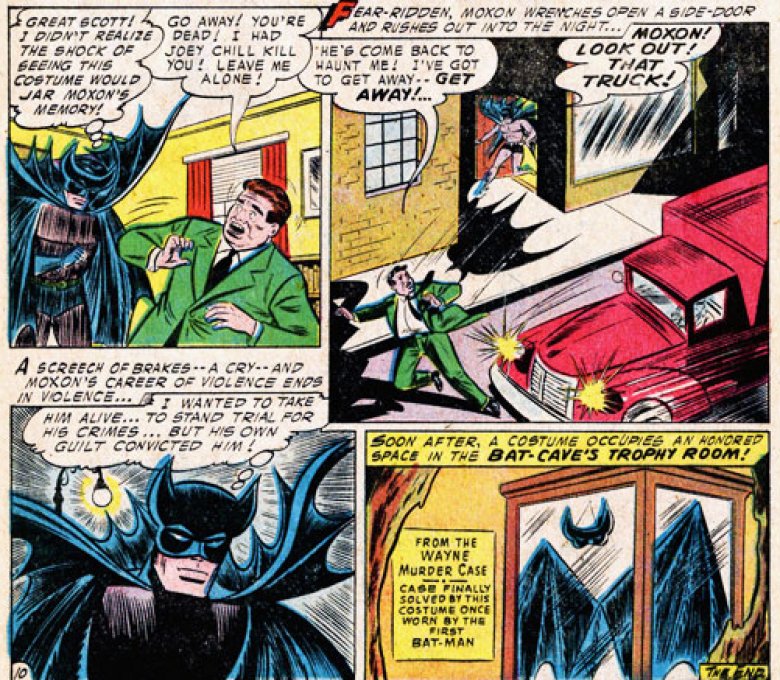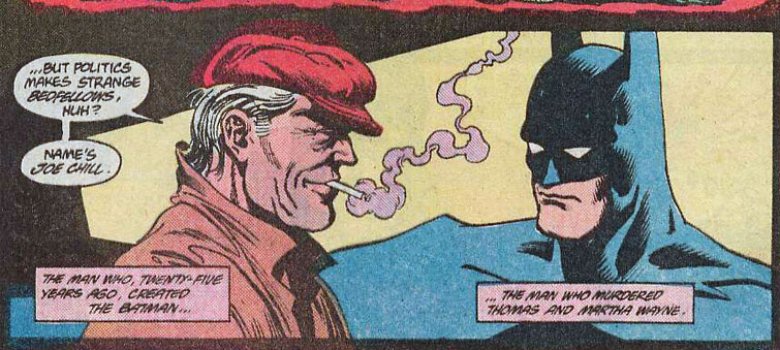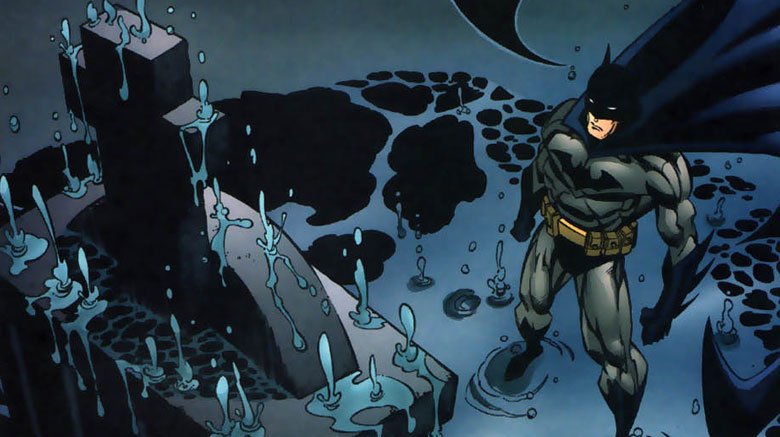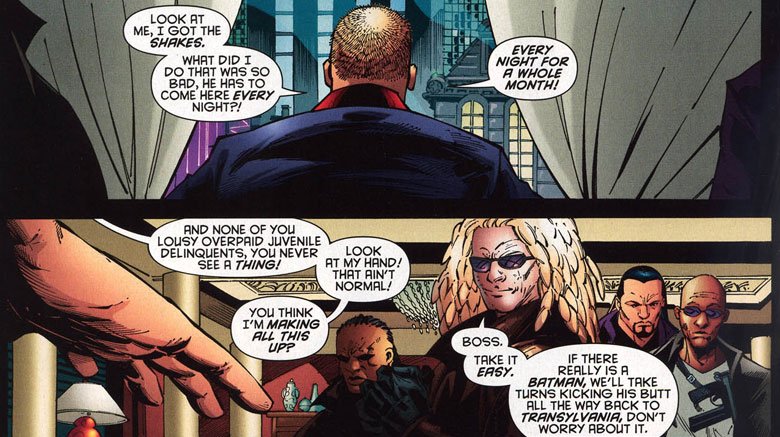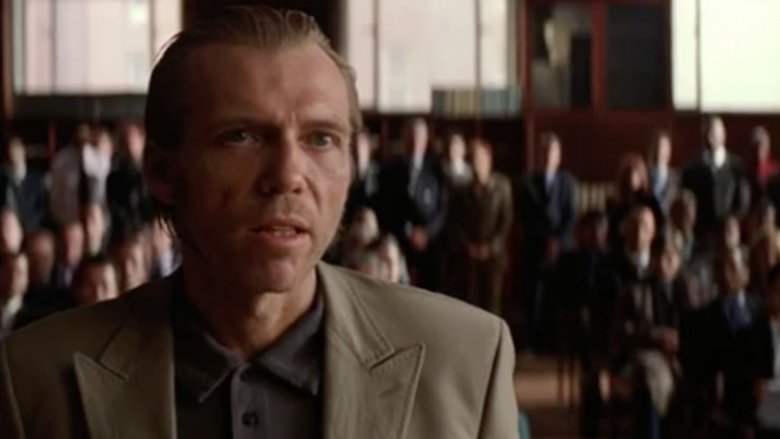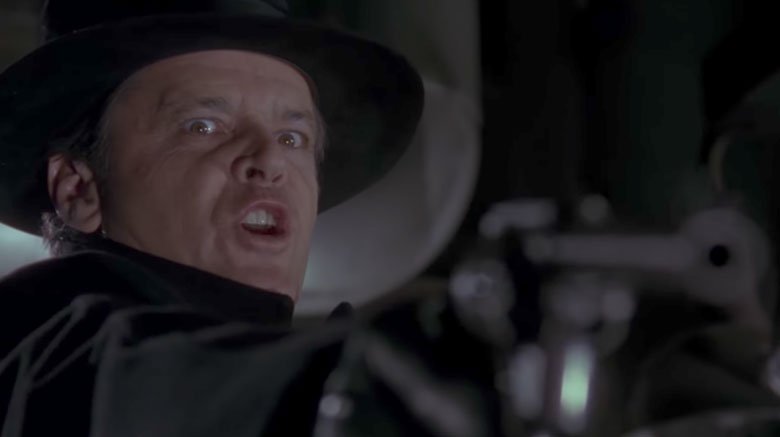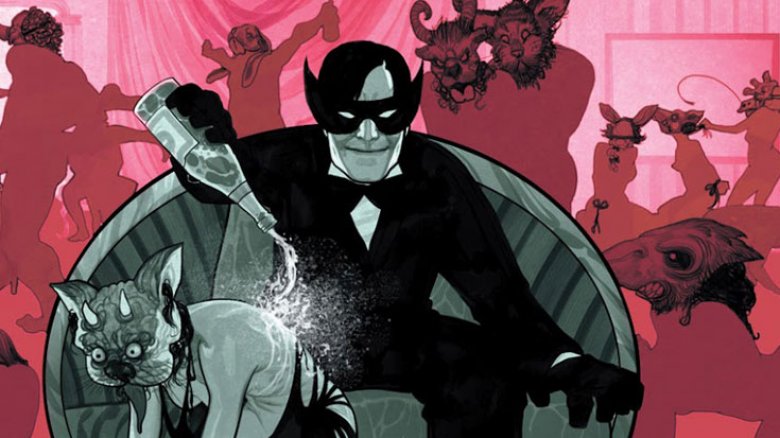Who Killed Batman's Parents?
A gunman stepped out of the shadows and murdered young Bruce Wayne's parents while the family was out for a stroll along Gotham City's Park Row, and there's a pretty good chance you know the rest of that side of the story. The street earns the nickname Crime Alley, and the child grows up to be Batman, the world's greatest crimefighter. But what about the guy on the other side of the gun?
Even though Thomas and Martha Wayne might get more attention, the person who pulled the trigger is arguably the single most important character in Batman's origin story. Without him, there's no vow to make war on all criminals, no rocket car sitting in the basement, no snarky butler who inexplicably raised a child—no Batman. And it all starts with a desperate criminal named Joe Chill.
Joe Chill
Looking back, it's a little surprising that the creators of Batman waited until 1948 to dive into the details of Joe Chill's origin, but to be honest, they were always a little slow on that score. They didn't give him an origin story at all until six months after his first appearance, in Detective Comics #33, and while that introduced Crime Alley and the trigger-happy mugger, it would be another eight years before he even had a name.
In Batman #47, Bill Finger and Bob Kane finally did the job with "The Origin of Batman." A chance encounter with a crooked trucking company specializing in transporting criminals across state lines led Batman to the company's owner, Joe Chill—and when he saw his face, the Caped Crusader immediately recognized the man who shot his parents all those years ago, and swore to bring him down once and for all. Rather than just clocking him in the jaw and dragging him off to jail, though, Batman confronted Chill personally, unmasking and explaining why he was about to exist entirely within a world made of batarangs and pain.
With the only other option being to stand there and lose his teeth four or five at a time, Chill ran into another room and explained his problem to a trio of henchmen. Unfortunately, he also had to explain that he was personally responsible for creating the single greatest scourge the criminal underworld had ever known, and his fellow crooks were pissed to the point of gunning him down before he could reveal Batman's identity. With that, Joe Chill was introduced and killed off in the span of a single 13-page story, closing the case on the Wayne murders forever.
Mrs. Chilton
... Except that's not quite what happened. A pretty huge wrinkle in Joe Chill's story came in 1969's Batman #208, in E. Nelson Bridwell, Gil Kane, and Jack Abel's "The Women In Batman's Life," which introduced the kindly Mrs. Chilton.
It's worth noting that one of the weirder aspects of Batman's history—the fact that he was seemingly raised as an orphan by the family butler, some true Old Money weirdness—is actually a relatively modern invention. In the Silver Age, it was explained that Bruce Wayne grew up living with his Uncle Philip, a businessman whose tendency to travel the world also gave young Bruce a way to learn from different cultures. Bruce's actual upbringing, however, fell to Philip's housekeeper, Mrs. Chilton, whose kindness to an angry young orphan was so profound that he referred to her as "Mom Chilton."
The twist? Mrs. Chilton had two grown sons of her own, and young Joe shortened his last name to "Chill" when he fell into a life of crime. And not only that, but she knew he murdered the Waynes, and that Bruce was Batman, something Alfred somehow found out along the way. The only one who didn't know was Bruce himself. Oh, and her other son, Max? Also a criminal, who was crushed to death by a slot machine while fighting Batman in an issue of Brave and the Bold.
The Joe Chill of the DC Animated Universe
Chill himself remains pretty consistent across most versions of Batman, but his death at the hands of his own henchmen isn't always the way he meets his end. In the DC Animated Universe—the continuity that began in 1992 with Batman: The Animated Series and continued up through the end of Justice League Unlimited—Chill got away with his crime. Mostly.
In 2004's Batman Adventures #17, technically the last Batman solo story of the DCAU, Ty Templeton and Rick Burchett presented a version of Chill who was never caught, but still suffered for his sins. While he didn't know Bruce Wayne was Batman, he was still quite aware that he had done something truly terrible to someone who grew up to have billions of dollars and a whole lot of free time. Even without the whole thing where he dresses like Dracula, that's pretty terrifying.
As a result, Chill lived with hallucinations of Bruce Wayne's face haunting him at every turn. When his career as a hitman caused him to tangle with Batman, Chill managed to tear off Batman's mask, and instead of realizing he'd just discovered Batman's secret identity, he thought he'd finally cracked under the pressure of his most famous murder. Recoiling in fear, Chill took a header off the nearest balcony, and refused to take Bruce Wayne's hand when Batman jumped after him. Batman, for his part, had no idea who Chill was, or why he reacted that way. Just another unsolved mystery, but as with many stories of Chill's death, it put an end to the question of who killed Batman's parents.
Lew Moxon
Except that Joe Chill wasn't really the one who killed the Waynes after all. Sure, he pulled the trigger, but rather than simply being a mugger, he was actually a hitman acting on orders from someone else: mob boss Lew Moxon.
As for why Moxon wanted the Waynes killed, that goes back to an old grudge that we first see in Detective Comics #235. When Moxon was wounded by police while fleeing the scene of a crime, his men stuck up a high-society costume party looking for a skilled surgeon to get the bullet out, and they found one: Thomas Wayne, who was dressed as—what else?—a bat. The thing is, Wayne briefly forgot his hippocratic oath and, rather than performing the operation, beat the living hell out of Moxon and his goons, sending them up the river for their crimes. Moxon vowed revenge, and when he was released, he hired Joe Chill in order to distance himself from the crime, and the rest is history.
Here's where it gets weird, though: by the time Batman tracked him down, Moxon was suffering from amnesia, and had no memory of his encounter with the Waynes or the hit. It was only when Bruce put on Thomas Wayne's old bat costume and confronted him that the shocking sight jarred his memory, sending him into a panic and causing him to flee directly into the path of an oncoming truck. Finally, the case of the Wayne Murders was closed. For a while, at least.
Batman: Year Two
It's worth noting that everything we've mentioned so far happened in the Golden and Silver Ages, but when DC rebooted their continuity in 1986, they wiped the slate clean for a new take on their complicated mythology. For Batman, the most famous example was his new origin story in Frank Miller and David Mazzucchelli's Batman: Year One, which kept the basics but updated it for the gritty crime wave of the '80s. The sequel, however, is far less well known—and completely buck wild.
Rather than making a stab at cowl-and-caped realism, Mike W. Barr, Alan Davis, and Todd McFarlane's Year Two was pure superhero drama, in which a murderous vigilante called the Reaper returned to Gotham after years of absence, with a brutality that even the Dark Knight couldn't stand against. In desperation, Batman decided to battle against the Reaper with a weapon he'd been holding in reserve for decades—the gun that killed his parents, lifted from the crime scene when he was a child—and struck a deal with Gotham's criminals to team up with their best triggerman: Joe Chill.
Batman's plan was to take down the Reaper and then turn the pistol on Chill in the ultimate act of poetic justice, but at the moment of truth, the decision of whether or not to kill his parents' murderer was taken from him when the Reaper did the deed instead. In the fight that followed, the Reaper was revealed to be the father of Batman's girlfriend, a story point that (very loosely) inspired the animated movie Mask of the Phantasm. Oh, and then there's a sequel to that story with a new version of the Reaper, who turns out to be Joe Chill Jr., out for revenge of his own. Comics are complicated, y'all.
Zero Hour
Despite the fact that the idea behind the character dated all the way back to 1948, another continuity shakeup in 1994—Zero Hour—resulted in Joe Chill being wiped completely out of continuity.
Instead of having an identified culprit, the murder of Batman's parents was recast as a random act of violence, with a lack of evidence that led it to being a permanently unsolved case. On a metaphorical level, removing Chill (and Moxon) from the equation meant Batman wasn't fighting crime in hopes of getting his revenge on a single person, but that he was at war with the very concept of Crime Itself. It became a question of whether he was seeking vengeance or altruistically trying to prevent what happened to him from happening to anyone else, with the added dramatic irony of the World's Greatest Detective being unable to solve what was arguably his most important case.
Of course, all that just raised the question that those original stories were trying to answer: what would happen if he did encounter his parents' murderer? Would he keep being Batman even after that case was closed? As it turned out, that question was just too good to resist for long.
Joe Chill In Hell
Rather than adhering to the strict guidelines of continuity, Grant Morrison's eight-year tenure as the primary Batman writer was marked by an approach where everything happened. The grim and gritty origin of Year One, the wildest sci-fi stories of the Silver Age—all of it appeared in some form or another, and in Batman #673, he and artist Tony Daniel put their stamp on the Waynes' murderer with "Joe Chill In Hell."
Drawing inspiration from the original story, Year Two, and everything in between, "Joe Chill In Hell" was set in Batman's early career, and opened with Chill justifying his crimes as "class warfare," and asking what he did that was so bad that he's been "haunted" by Batman every night for a month. Finally, after terrorizing Chill and proving there was nothing he could do to keep him from showing up whenever he wanted, Batman confronted Chill, explaining who he was and returning Chill's gun.
Chill, faced with the prospect of having created the single most dauntless foe in history—and being faced with the knowledge that if the underworld discovered he was responsible for Batman, they'd kill him just like they killed his Golden Age counterpart—turned his murder weapon on himself and committed suicide after Batman left him for the final time.
Joe Chill in the Dark Knight Trilogy
In 2005's Batman Begins, Joe Chill, played by Richard Brake, made his way off the comics page and onto the movie screen. Like the original 1948 version, Chill was a simple mugger who encountered the Wayne family as they were walking through a suspiciously grimy alley right next to a high-society opera house, robbing them and shooting young Bruce's parents in a struggle.
The twist was that rather than vanishing into the night, Chill was arrested that same day, convicted of the double murder, and sentenced to prison. It was only years later that he struck a plea bargain, providing information on Gotham City crime boss Carmine "The Roman" Falcone. Even though he expressed great remorse for what he'd done, that didn't do much to placate Bruce Wayne and his incredibly floppy hair, who fully intended to shoot Chill dead on the steps of the courthouse. He never got the chance, though; Chill was murdered by one of Falcone's hitmen before he could testify.
There's one more wrinkle to the cinematic Joe Chill, however: much like twist of the Lew Moxon story, he's really just a patsy. He's not a hired hitman this time, though: according to Ra's al-Ghul, Chill had only been driven to crime because of the socioeconomic conditions that the League of Shadows had created in an effort to destroy the hive of corruption that was Gotham City. That seems like a long way to go just to kill a couple of one-percenters, but you can't expect a secret society of fear gas ninjas to ever take the simple route.
Jack Napier
The other major cinematic example of the Wayne murders took a completely different route. Rather than sticking with Joe Chill, Tim Burton and Sam Hamm's 1989 Batman movie combined Joe Chill and the Joker to create a new character: Jack Napier.
It's easy to see why they would, too. Instead of viewing superheroes the way comics do—as ongoing characters with a variety of villains in a continuing story that's never meant to end—Hollywood producers structured a lot of superhero movies as simple action movies. By that logic, Batman was no different from, say, Commando, and required a single villain with a personal connection so the hero could spend the movie getting revenge. By that logic, Batman's greatest enemy, the Joker, had to be the guy who killed his parents, even if that didn't make a whole lot of sense in practice.
Also, congratulations! You are now aware that "Jack Napier" is a pun on "jackanape," another word for a joker. And here you thought the Batman movies didn't get around to truly terrible puns until Mr. Freeze showed up in Batman and Robin.
Dr. Hurt
With all we've been through so far, it should come as no surprise that there's one final twist to Joe Chill and the question of who really killed Batman's parents. Another element introduced during Grant Morrison's run on the Batman titles was the character of Dr. Hurt—who claimed, among other things, to be Thomas Wayne, who'd secretly survived the mugging and had now returned to ruin both Batman and the Wayne family name. (Dr. Hurt also claimed to be the devil, but you know how these things are.)
One of his more outrageous claims, as seen in Morrison and Frazer Irving's Batman Incorporated #11, was that it was Thomas Wayne who hired Joe Chill to kill his wife and son, freeing him to lead a life of Satanic debauchery as the villain he truly was. At the last minute, Chill got cold feet and turned his gun on Thomas instead, leaving Bruce alive to become Batman and Thomas critically wounded to fake his death, returning as a member of the sinister organization called the Black Glove.
Eventually, it was all revealed to be false. The true explanation was a whole lot simpler: Dr. Hurt was actually just a mysterious scientist who may or may not be an actor who was coincidentally an exact double of both Thomas and Bruce Wayne named Mangrove Pierce, a demonic force summoned by Thomas Jefferson called Barbatos, a time-traveling "hyper-adapter" sent to kill Batman from space by Darkseid, an immortal ancestor of the Wayne family kept alive by black magic, or possibly just the devil himself. We're not sure why readers had a hard time with this story. It seems pretty straightforward to us.
